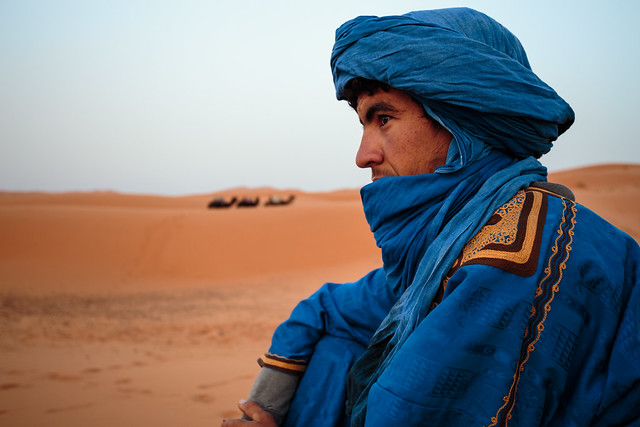The Secret of Surviving in the African Sahara Desert
Sahara Desert clothing survival secret is the thawb and keffiyeh made from ancient engineering knowhow.
The Sahara desert peoples clothing has to solve three clothing challenges, an unforgiving sun, relentless sandy winds and extreme dryness.

The secret of surviving in the African Sahara Desert is wearing the right clothing.
The desert dweller clothing, a thawb and keffiyeh, made of breathable fabric worn loose in layers cools the body by convection.
The world’s largest hot desert and the third largest desert in the world, the Sahara is one of the most unforgiving locations on the planet, covering 8.5 million square kilometers or 3.3 million square miles, about the size of the South American country of Brazil.
The Sahara makes up 25 percent of the continent of Africa. However, the Sahara is by no means an empty wasteland, desert dwellers work, love and dream on the Sahara’s sand and gravel for a thousand years living with hurricane-force sandstorms and annual rainfall that averages less than an inch a year.
The average daytime temperatures can top 130 degrees, by night; however, temperatures can drop to the 40 degrees and plummet below freezing in the mountain areas. The Sahara desert peoples clothing has to solve three clothing challenges, an unforgiving sun, relentless sandy winds and extreme dryness.
For those reasons, clothing in the desert needs to protect the wearer’s skin from the sun, filter out sand particles and conserve moisture. The design of the Sahara desert peoples clothing must be functional. How does being wrapped in thick cotton fabric from head to toe cool you off? Think light and loose, think thawb.
The thawb is an ankle-length garment, usually with long sleeves, similar to a robe. The thawb, even though ankle length, cools you off, by allowing sweat to evaporate. Evaporation drains the heat from your body. To help the sweat evaporate, you want air to flow over your skin as much of your skin as possible.
The desert dwellers loose clothing allows air to pass along the skin and exit, speeding evaporation and carrying off excess heat. The outer layer of fabric does get hotter because it absorbs more heat. Moreover, that heat is not transmitted to the skin because of the thick fabric.
However, thin clothing transmits that heat to the skin, making a person hotter, the key here is breathable thickness. The head cloth or keffiyeh is the most characteristic part of the desert dweller clothing. The keffiyeh is made of a breathable material cloth, folded and wrapped into various styles around the head.
There are many local variations of the keffiyeh. Some wearers wrap the keffiyeh into a turban, while others wear it loosely draped around the back and shoulders. The ends of the head cloth are wrapped around the face and neck acting as protection from the cold, a shield from the sun's heat, and a screen to keep the wind and sand out.
Did you know? Keffiyeh has various spellings such as kaffiyah, keffiya, kaffiya, or kufiya, as well as alternate names depending on the region, shmagh, shemagh, ghutra, or hatta. Sahara Desert clothing survival secret is the thawb and keffiyeh made from ancient engineering knowhow.
Together we build awareness that boost harmony, education, and success, below are more links to articles you will find thought provoking.
- African Country Names Your Saying Wrong
- What do Waist Beads Symbolize in Africa?
- About African Healers and Witchdoctors
- Hurricanes are Angry African Ancestors
- Highest Temperature and Lowest Temperature in Africa
- About African Night Running







